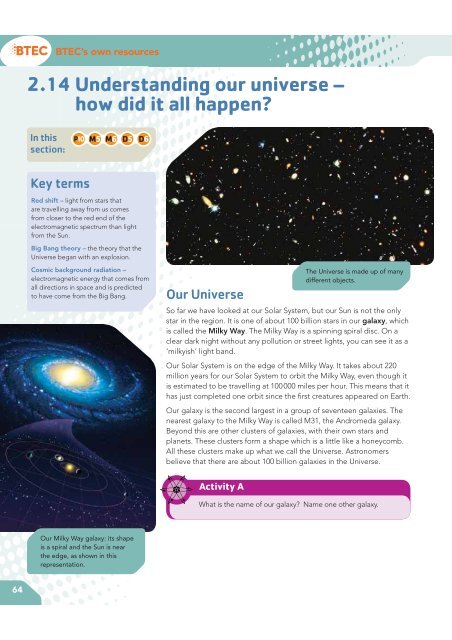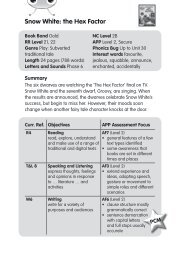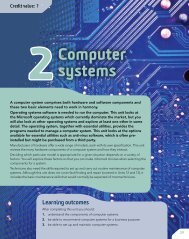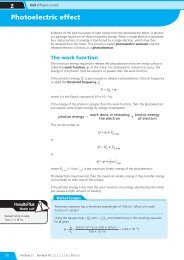Energy and our Universe - Pearson Schools
Energy and our Universe - Pearson Schools
Energy and our Universe - Pearson Schools
You also want an ePaper? Increase the reach of your titles
YUMPU automatically turns print PDFs into web optimized ePapers that Google loves.
64<br />
2.14 Underst<strong>and</strong>ing <strong>our</strong> universe –<br />
how did it all happen?<br />
In this<br />
section:<br />
BTEC’s own res<strong>our</strong>ces<br />
Key terms<br />
P10 M5 M6 D5 D6<br />
Red shift – light from stars that<br />
are travelling away from us comes<br />
from closer to the red end of the<br />
electromagnetic spectrum than light<br />
from the Sun.<br />
Big Bang theory – the theory that the<br />
<strong>Universe</strong> began with an explosion.<br />
Cosmic background radiation –<br />
electromagnetic energy that comes from<br />
all directions in space <strong>and</strong> is predicted<br />
to have come from the Big Bang.<br />
Our Milky Way galaxy: its shape<br />
is a spiral <strong>and</strong> the Sun is near<br />
the edge, as shown in this<br />
representation.<br />
Our <strong>Universe</strong><br />
The <strong>Universe</strong> is made up of many<br />
different objects.<br />
So far we have looked at <strong>our</strong> Solar System, but <strong>our</strong> Sun is not the only<br />
star in the region. It is one of about 100 billion stars in <strong>our</strong> galaxy, which<br />
is called the Milky Way. The Milky Way is a spinning spiral disc. On a<br />
clear dark night without any pollution or street lights, you can see it as a<br />
‘milkyish’ light b<strong>and</strong>.<br />
Our Solar System is on the edge of the Milky Way. It takes about 220<br />
million years for <strong>our</strong> Solar System to orbit the Milky Way, even though it<br />
is estimated to be travelling at 100 000 miles per h<strong>our</strong>. This means that it<br />
has just completed one orbit since the fi rst creatures appeared on Earth.<br />
Our galaxy is the second largest in a group of seventeen galaxies. The<br />
nearest galaxy to the Milky Way is called M31, the Andromeda galaxy.<br />
Beyond this are other clusters of galaxies, with their own stars <strong>and</strong><br />
planets. These clusters form a shape which is a little like a honeycomb.<br />
All these clusters make up what we call the <strong>Universe</strong>. Astronomers<br />
believe that there are about 100 billion galaxies in the <strong>Universe</strong>.<br />
Activity A<br />
What is the name of <strong>our</strong> galaxy? Name one other galaxy.

















